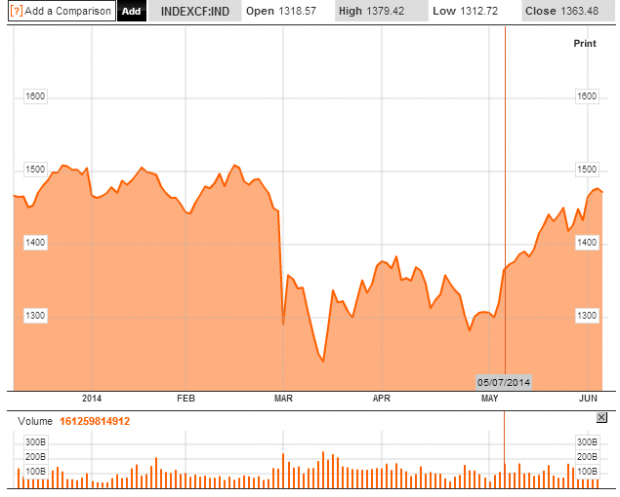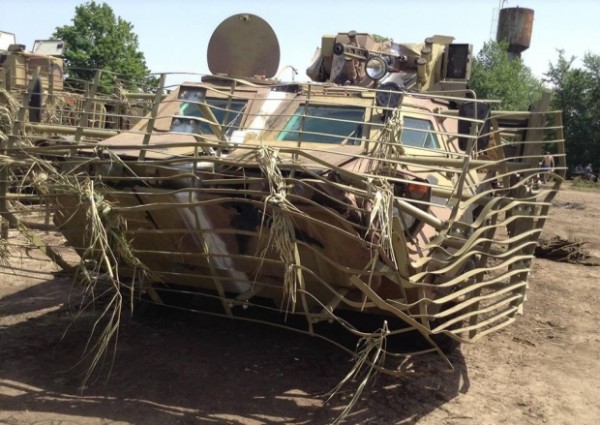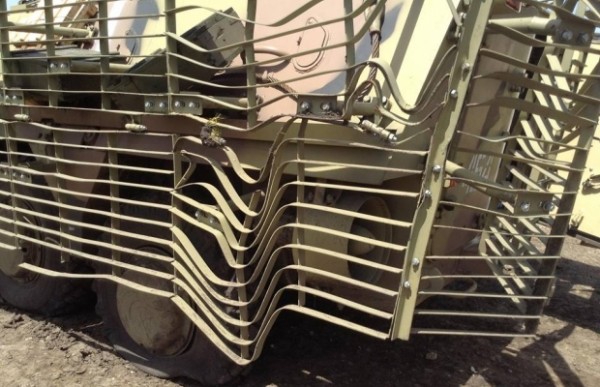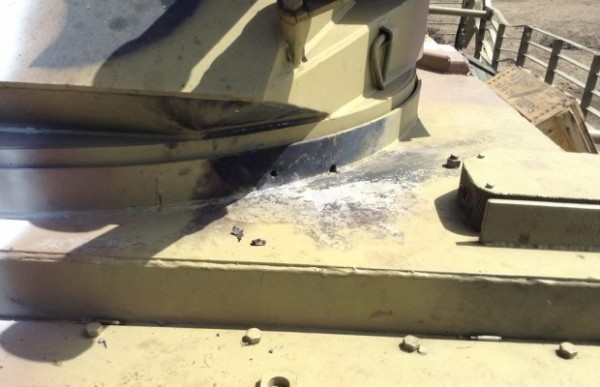Yesterday’s liveblog can be found here. For an overview and analysis of this developing story see our latest podcast.
Please help The Interpreter to continue providing this valuable information service by making a donation towards our costs.
An interactive map of the situation:
View Ukraine: April, 2014 in a larger map
For links to individual updates click on the timestamps.
Below we will be making regular updates. Be sure to check back often and hit refresh.
While not quite at the levels that they were before the Yanukovych government started to founder in February, Russian stocks are now higher than they were before Russia invaded Crimea.
Today was the first day all week that the MICEX index lost value (it was down .34% today), but Russia’s stock market which was staring disaster in the face not long ago is only down 2.15% for the year. As Russia’s economy was, according to many experts, already destined to slide even before this crisis began, this is good news for Russian President Vladimir Putin.

Russian stocks were down today on news that the Russian government may raise the capitalization for the state-owned energy giant Gazprom. Business Week reports:
The Micex Index dropped 0.1 percent to 1,474.30 by 5:35 p.m. in Moscow after closing at the highest level since Feb. 25 yesterday. Gazprom retreated 0.5 percent and VTB Group lost 3.8 percent, the stock’s first decline in four days.
Gazprom’s eastern Siberian gas pipeline to China may be financed by additional capitalization or with an advance gas payment from China, Putin said yesterday at an energy meeting in Astrakhan, Russia. Stocks have rebounded to levels last seen before Putin’s incursion into Crimea in March as prospects of tougher U.S. and European Union sanctions fade.
“Gazprom shares will remain under big pressure since the government is planning additional capitalization, which may dilute existing shareholders’ stakes,” Vadim Bit-Avragim, who helps oversee about $4.1 billion at Kapital Asset Management LLC in Moscow, said by e-mail. “It’s a strange proposal since Gazprom has the capacity to build the pipeline to China without extra capitalization. ”
Despite this minor setback the trend remains clear. Many Russia observers are looking at today’s battles on Ukraine’s border as the clearest and most concerning sign that Russian interference is destabilizing Ukraine, at least since the Crimean annexation. And yet Russia’s markets don’t seem to have noticed these incidents, the Western media is largely devoid of reports of the fighting on the border, and it’s not clear that world leaders are willing to pass additional sanctions against Russia over the flow of Russian militants into eastern Ukraine.
There is now a total disconnect between the deepening crisis in eastern Ukraine and the price Russia is paying for helping to deepen that crisis.
What we have witnessed in the last several weeks has been the start of a new phase of the conflict in Ukraine. Russian-backed separatists, swelling in numbers and wielding increasingly powerful (and Russian made) weapons, have captured Ukrainian military bases, including National Guard bases and Border Guard posts, across parts of eastern Ukraine.
The fall of those bases have given the separatists several advantages. First, it is a major boost for morale. Secondly, it has provided them with more weapons, including armored vehicles and Igla anti-aircraft missiles. Not only does this serve an obvious purpose, but it provides the separatists with plausible deniability when it comes to the source of their weapons. Whereas before many eyebrows were raised by the amount of firepower in the hands of these “rebels,” now the separatists (and the Kremlin) can say that they got them from captured bases. Third, as we’ve been writing, the victories have opened up the borders, allowing more Russian fights, and possibly weapons and heavy equipment, to come and militarily support the rebel fighters.
In the last two days, the G-7 has been meeting in Brussels. The summit was supposed involve the G-8 and was supposed to take place in Sochi, Russia, but the Russian Federation was dis-invited to its own summit. The G-7 has decided not to pass more sanctions against Russia at this moment. Here is an excerpt from the press release sent by The White House today:
G-7 leaders discussed the situation in Ukraine and stand united in support of the efforts of the people of Ukraine to build a deeper and stronger democracy that accommodates the rights and aspirations of all people in all regions of Ukraine. Despite violence and intimidation, strong voter turnout for the May 25 presidential election underscores the determination of Ukraine’s citizens to determine the future of their country. Against this backdrop, G-7 leaders discussed their commitment to support Ukraine as it works to unite the country and transition to an inclusive democracy and prosperous market-driven economy and their determination to raise the cost for Russia of continued actions to undermine Ukraine’s sovereignty and territorial integrity.
Response to Russian Actions
G-7 leaders also agreed that coordinated actions must continue to raise the cost of Russia’s unacceptable interference in Ukraine, including the occupation of Crimea in violation of international law and the ongoing efforts to destabilize Ukraine’s east and south. G-7 leaders have taken a number of steps to impose economic costs on Russia and committed to take further intensified measures if needed. Specifically, all G-7 members have:
• Imposed sanctions on individuals and entities who have actively supported or implemented the violation of Ukraine’s sovereignty and territorial integrity or who are threatening the peace, security, and stability of Ukraine.
• Committed to supporting a diplomatic solution and called on Russia to fulfill the commitments it made in the Geneva Joint Statement to pursue a diplomatic path and cooperation with the government of Ukraine as it implements it plans for promoting peace, unity, and reform.
• Called on Russia to recognize the results of the Ukrainian election, complete the withdrawal of its military forces on the border with Ukraine, stop the flow of weapons and militants across the border, and exercise its influence among armed separatists to lay down their weapons and renounce violence.
• Affirmed their readiness to intensify targeted sanctions and to implement significant additional restrictive measures to impose further costs on Russia if necessary.
But Russia’s stock market has rallied and erased most of the losses it has suffered as a result of this crisis and the previous rounds of sanctions. So while there is an acknowledgement that Russia is still playing the role of provocateur, the statements from the G-7 lead with Crimea as the headline. In reality, the provocations in eastern Ukraine are a far more pressing problem.
In separate statements, U.S. President Barack Obama has stressed that the current crisis is moving Ukraine into dangerous waters. Financial Times reports:
“We can’t simply allow drift,” Mr Obama said. “The mere fact that some of the Russian soldiers have moved back off the border, and Russia is now destabilising Ukraine through surrogates rather than overtly and explicitly, does not mean that we can afford three months or four months or six months of continued violence and conflict in eastern Ukraine.”
Russia’s foreign ministry reacted angrily to accusations that it was responsible for weapons shipments to rebels in eastern Ukraine. “These unfounded allegations on Ukraine’s part that trucks with weapons are crossing the border, et cetera, this is all the work of the devil,” said Alexander Lukashevich, the foreign ministry spokesman, according to Interfax.
But will the G-7, and both the U.S. and the EU, hold Russia to those standards, or is the Russian troop pullback good enough for them?
Before today’s fighting at various border checkpoints, Russian-backed separatists had already opened a hole in Ukraine’s border that allows Russians — even armed ones — to flock into Ukraine. In a report for The Daily Beast, Anna Nemtsova says that, despite claims that Russia is deescalating the situation by claiming to withdraw from Ukraine’s borders, now that this hole has been opened “the real war is about to begin.”
Two local taxi drivers, Aleksei and Vladislav, drove us to the crossing point, which is called Krasny Partizansk in Russian or Chervono Parizansk in Ukrainian. Shortly before we arrived, armed rebels took over the base and took down the Ukrainian flag.
There is now no flag at the border. It is now nobody’s border, the locals are joking. One of the rebels told us that no passports or identity papers had to be checked on this side of the frontier any longer. We saw cars crossing into Russia with only Russian customs checking their papers.
This was published by Nemtsova yesterday. Below we have several reports of fighting along the border, and at least one of the battles is fierce enough that it is still ongoing and Ukraine has had to conduct airstrikes to defeat the attackers. Several more border posts have fallen since this was published, and it looks like this trend will only accelerate.
Ukraine has essentially lost the border, and with it Kiev may now lose the east.
Another serious headline from the official Ukrainian Border Services (SBSU) website:
Translation: “The status as of 18:30: battle with terrorists at the Marinovka checkpoint continues. Aviation has already twice delivered strikes.”
The SBSU website says that the battle is ongoing, Ukrainian air forces have conducted two strafing runs, the nearby grass is on fire, and the attackers are losing. This is the report that says that three border guards have been wounded.
There are major accusations today that small units of well-armed militants, some of whom are traveling in armored vehicles, are crossing the Russian border and engaging in firefights with Ukrainian border guards. We opened our coverage today with reports that insurgent victories in Lugansk have been aided by these cross-border attacks. In that report, we mentioned that local witnesses saw Russian armored vehicles crossing the border to help the separatists, the former Interior Minister reported 15 trucks of militants crossing the border, and Ukrainian military expert Dmytro Tymuchuk claimed that two different border checkpoints north of Lugansk came under attack.
Now, Tymchuk reports that 1 APC, 4 Kamaz trucks mounted with heavy machineguns, 3 minibuses and 4 cars filled with militants have all crossed the border near the Marinovka checkpoint, north of Lugansk, we believe approximately here on our interactive map.
Newsone.biz is carrying this report, which has been translated by The Interpreter:
Miltia Attack Marinovka Border Checkpoint in Donetsk Region
The attack began at 16:05.
Today, June 5 at about 15:15 in the area of the Marinovka border checkpoint in Donetsk Region, Ukrainian border guards discovered a BTR [APC], four KaMAZ trucks outfitted with large-caliber Utes machine-guns, three minivans with militia and four passenger cards.
As the State Border Services of Ukraine (SBSU) press service reports, one kilometer from the checkpoint, the column deployed in battle formation. As the SBSU reported, at 16:05 the attack on the checkpoint began, and the staff of the SBSU took fire.
“The status as of 16:50 is that one KaMAZ is damaged, and a large-caliber machine gun is destroyed. All the relevant forces and divisions have been informed. A detachment formed of the SBSU and the Ukrainian Armed Forces is headed toward the checkpoint,” the SBSU reported.
In Lugansk Region, two checkpoints have been closed.
We will recall that on the night of 4 June, unidentified persons attacked the checkpoint at Marinovka. After retaliatory fire from the border guards, the attack was stopped.
The time is now approximately 18:50, so these reports are about two hours old.
Meanwhile, this video claims to show several Russian BTR armored vehicles racing toward the Ukrainian border to the south, near Rostov on Don and racing toward Amvroseyevka (map). While the video has not been verified, the topography matches (as does the weather report), but the date is not confirmed. The problem is that, months ago, when large amounts of Russian troops were on the move, there were many eyewitness reports and videos. Two vehicles, or smaller convoys, moving on major highways, might pass witnesses by before they have the chance to video the vehicles. In other words, these claims are very hard to prove, or disprove.
The reports of Russian troops and vehicles crossing the border have not been independently verified, but the frequency of those claims over the last few days has been alarming, and coincides with a sudden surge in separatist military assaults, and victories.
The Ukrainian government appears to be losing control of the border, which means that the flood of Russian fighters across the border may be unstoppable at this moment without a significant change in fortune for the Ukrainian military.
This video, posted on June 4th, reportedly shows a separatist leader in Gorlovka (or Horlivka), Igor Bezler, executing two prisoners and promising to execute two more every one-and-a-half hours until his own men are released by Ukrainian authorities. He even references the Ukrainian government’s refusal to engage in a prisoner exchange.
Though bloodless, the video may be disturbing to some viewers:
Here is what we know:
– That video was taken during this conflict. The man speaking in
the video talks about the current crisis, and levels his threats
directly against the Ukrainian SBU. It is not old, as in from some other
conflict, but it may or may not have been taken on June 4th.
– The man speaking does look and sound like separatist leader Igor Bezler. In a video from
April 14th, Bezler can be seen addressing the separatists. The men have
a similar nose, and similar ears, and similar voices, with a slight
lisp that is somewhat common. The man in the execution video has a
deeper voice, though he may be speaking in a different tone, and audio
taken with closer proximity, and indoors, will capture the bass better.
The moustache of the men is different, but as people have done research
into Bezler, one finds earlier pictures that show a very similar
moustache:

We can conclude with a high degree of certainty that this video was
taken recently. The man speaking may very well be Bezler, which means
that the men with the guns are probably Russian-backed separatists.
What we don’t know
Is this a real execution? There are some reasons to suggest that this incident was staged.
There is no blood. The prisoners both fall at the same time as the
shots ring out and never move after that. It is surprising that an
execution conducted this way would result in an instantaneous kill, and
yet the ‘executed’ make no sound or movements after the gunshots. There
is no muzzle flash, and the audio never fully distorts, suggesting that
the gunfire was perhaps not as loud as we might expect from a real
gunshot.
It is possible that the men were shot at with blank ammunition, and
that this is an intimidation technique, but without a better look at
the bodies, which the videographer clearly avoids giving us, at least in
this clip, we cannot be certain.
But there is an allegation that Bezler has faked executions before. Joe Galvin has shared a story in the Open Newsroom
that may match the video we’re seeing, or at least suggest that faking
an execution is a tactic that this group of separatists may have tried
in the recent past.
The following is a translation of a story, published on Ostro.org on May 29th,
that reports that Bezler staged two executions in the basement of his
headquarters, very likely this very same basement. That story remains
unconfirmed (translation by The Interpreter):
29.05.2014 13:00
“Executed” Policemen Released in Gorlovka. But Not for Free
Policemen
held captive by separatists in Gorlovka whose “execution” was staged 27
May by the terrorist Bes [Demon, or Igor Bezler] have been released,
law-enforcement sources report close to one of the policemen.According
to the sources, R. Babyuk, deputy head of the criminal police of
Kalinsky District and D. Krikunov, head of criminal investigation of the
same district were released by separatists this morning, but their cars
had been seized and both were severely beaten.The policemen
were detained 27 May and held in the basement of the Gorlovka
Anti-Organized Crime Department. That same day, the execution of Babyuk
and Krkunov was staged “for violation of the oath of the DNR [Donetsk
People’s Republic].” Two men with sacks over their heads were brought
before the staff of the district department, and the “commissar” of
Gorlovka, Aleksandr Shulzhenko, the former head of the city patrol
service, read out the order for execution, and the terrorist Bezler
carried out the executions with his people. That compelled A.
Krishchenko, the head of the Gorlovka city police administration to
announce that the officers had been executed. But later it turned out
that the “execution” was done with blank cartridges.According to
unofficial information, the terrorists still executed two men, but not
Babyuk and Krikunov. Their identities are not known.the district
department, and the “commissar” of Gorlovka, Aleksandr Shulzhenko, the
former head of the city patrol service, read out the order for
execution, and the terrorist Bezler carried out the executions with his
people.
Dmytro Tymchuk of Information Resistance reported, in a Facebook post today, that (translated by The Interpreter):
A column of ATO forces was fired on while returning to their camp. The attacking terrorists’ minibus was destroyed by returning fire. There are no casualties among the security forces.
A terrorist ammunition dump near Semyonovka, outside Slavyansk, was struck yesterday by security forces, burning for several hours. Throughout this time, ammunition was recorded exploding.
Meanwhile, the government appears to be reinforcing the ATO around Slavyansk with heavier and more effective armoured vehicles. Videos have been uploaded showing both T-64 heavy tanks and modern, Ukrainian developed BTR-4E armoured personnel carriers in the area. Note that one of the T-64s being shown to the camera here appears to have sustained battle damage.
This video purportedly shows BTR-4Es entering the town of Krasny Liman, near Slavyansk, yesterday (note that the preview image is not from the video itself):
The BTR-4E appears far better suited for urban fighting and counter-insurgency duties than the Soviet-era BTR-70s and 80s which have been lost on a number of occasions to enemy fire. The BTR-4E carries slat armour which assists greatly in deflecting grenade attacks.
On Tuesday, Arseniy Avakov, the Ukrainian interior minister, reported that one BTR-4E had received multiple hits from an RPG near Semyonovka, but had survived. Photos of the vehicle were uploaded by the journalist Yuri Kasyanov:



Following yesterday’s capture of two State Border Guard Service (SBGS) bases and one National Guard barracks in the Lugansk region, there are fears that the Ukrainian government, while appearing to make gains in their operations in the Donetsk region, are losing control of its north-eastern neighbour. One of the captured SBGS bases was, along with the National Guard base, in the city of Lugansk, the other SBGS base was in the town of Sverdlovsk, near to the Russian border.
Reporting on the capture, without combat, of the Sverdlovsk base by separatist fighters, journalist Roman Bochkala noted that there were reports from locals that large numbers of trucks and even armoured personnel carriers had crossed over the border beforehand. The government’s Anti-Terrorism Operation forces have not been committed, beyond limited air support, to relieving security forces under attack in thee Lugansk region.
Today, UNIAN reports that Yuriy Lutsenko, a former interior minister of Ukraine and the leader of the Third Ukrainian Republic party, has written on his Facebook page that 15 trucks carrying separatist fighters crossed from Russia into Ukraine overnight:
“Yesterday, border guards abandoned a frontier post covering 130km of the state border in the Lugansk region”, he wrote.
“Already, during the night, 15 Kamaz trucks carrying terrorists have entered this gap”, said the former minister.“Today, they will come to the aid of the militant groups in the Donetsk region, against whom the ATO is being conducted”, noted Lutsenko.
The state of the border controls was demonstrated by the following announcement from the Lugansk Regional Chamber of Commerce, pointing out that some border posts had had to close to due a lack of enough guards:
The Lugansk Regional Chamber of Commerce informs importers and exporters that, as of today, the Dolzhansky and Krasny Partizan border checkpoints are closed due to the effective absence of border guards at them, making it impossible to perform customs checks at the checkpoints. Be advised that the Izvarino and Krasnaya Talovka border checkpoints are operating as normal, as well as all of the checkpoints in the north of the Lugansk region.
Meanwhile, Dmytro Tymchuk of Information Resistance reported, on his Facebook page, that there had been two attacks on security checkpoints in the north of the Lugansk region:
Two Ukrainian security checkpoints in the north of the Lugansk region have been attacked in recent hours. Servicement returned fire, they have suffered no losses.
All translations by The Interpreter.